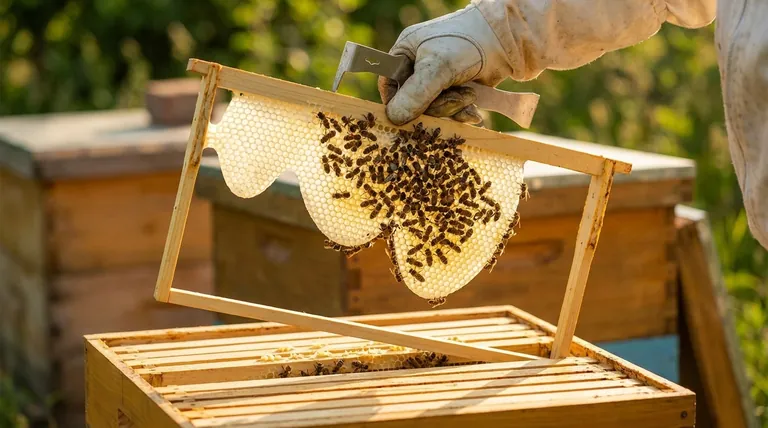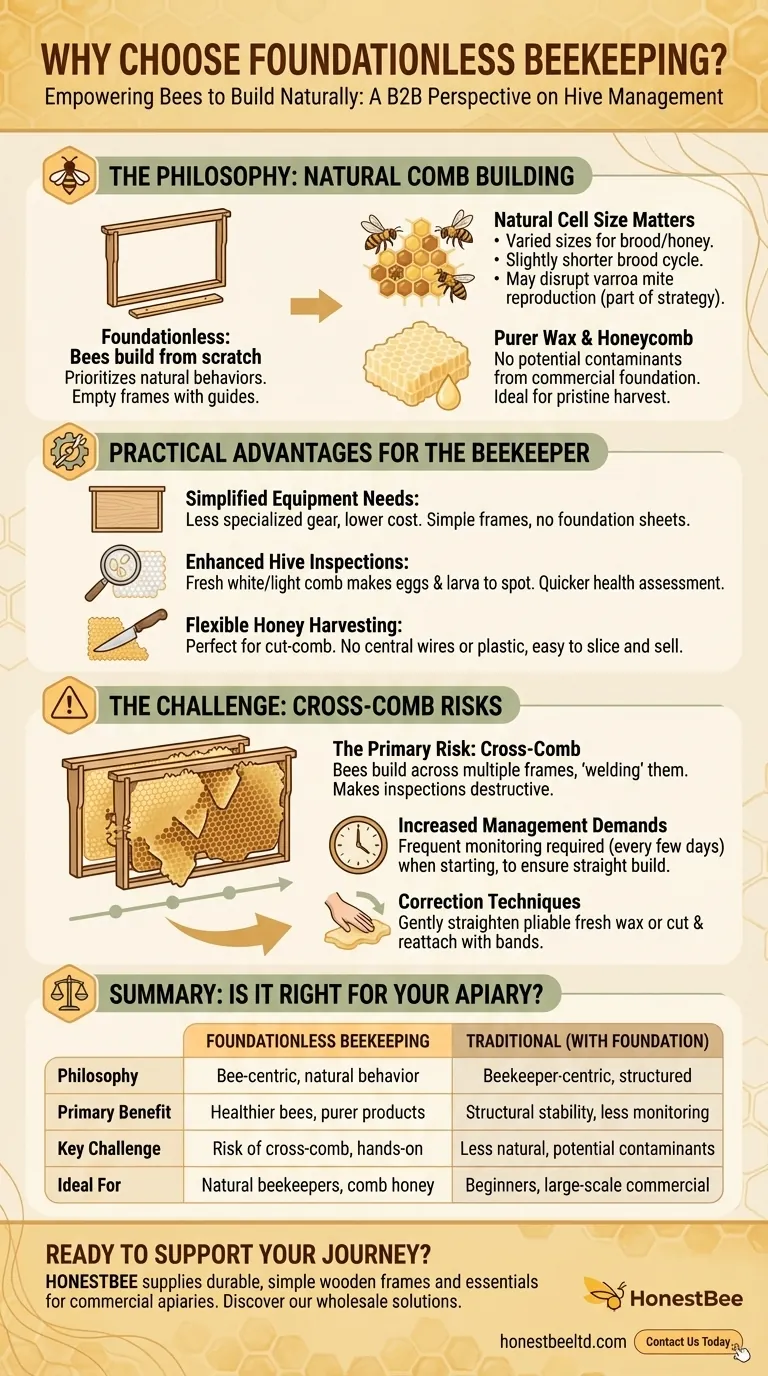Ultimately, beekeepers choose to go foundationless to allow honey bees to build comb naturally, according to their own instincts. This method avoids the use of pre-made plastic or wax foundations, giving bees control over the size and structure of their honeycomb, which many believe results in a healthier and more natural hive environment.
The decision to go foundationless is a trade-off between bee autonomy and beekeeper control. It promotes a more natural hive ecosystem and can yield purer products, but it requires more diligent monitoring from the beekeeper to prevent structural problems within the hive.

The Philosophy of Natural Comb Building
Going foundationless is rooted in a bee-centric approach to beekeeping. It prioritizes the natural behaviors of the colony over the structured convenience offered by commercial hive components.
What is Foundationless Beekeeping?
Foundationless beekeeping is the practice of providing bees with empty frames, often equipped with only a small starter strip or guide along the top bar. Instead of being forced to build on a pre-molded sheet of wax or plastic, the bees draw out their own comb from scratch.
Why Natural Cell Size Matters
When left to their own devices, bees build comb with varied cell sizes for different purposes, such as raising worker bees, drones, or storing honey. Some evidence suggests that allowing bees to build smaller, natural-sized cells for brood can slightly shorten their development time.
This reduced hatching period can disrupt the reproductive cycle of the varroa mite, a major pest, potentially leading to lower mite levels. However, this is not a complete mite solution and must be part of a larger pest management strategy.
Purer Wax and Honeycomb
Commercial foundation can sometimes contain trace contaminants from pesticides or chemicals accumulated over time. By building their own comb, bees create perfectly pure wax, which is ideal for those who wish to harvest pristine honeycomb or render their own clean beeswax.
Practical Advantages for the Beekeeper
Beyond the philosophical appeal, foundationless beekeeping offers tangible benefits in hive management and harvesting.
Simplified Equipment Needs
This method requires less specialized equipment. Beekeepers can use simple wooden frames with a beveled top bar or a small wooden guide, eliminating the cost and effort of buying and installing sheets of foundation.
Enhanced Hive Inspections
Freshly drawn natural comb is typically white or light yellow. This pristine background makes it significantly easier for the beekeeper to spot tiny eggs and developing larvae, allowing for a quicker and more accurate assessment of the queen's laying pattern and the colony's health.
Flexible Honey Harvesting
Foundationless frames are perfect for producing cut-comb honey. Because there is no central plastic sheet or reinforcing wires, a beekeeper can simply cut out a section of honeycomb directly from the frame for consumption or sale, a process that is much more difficult with standard foundation.
Understanding the Trade-offs and Risks
The primary drawback of this method is the loss of control, which can create significant structural problems if not managed carefully.
The Primary Challenge: Cross-Comb
The most significant risk is cross-comb (or "off-comb"), where bees build their comb at an angle across multiple frames instead of straight down within a single frame. This effectively "welds" the frames together, making hive inspections impossible without destroying the comb and potentially harming the queen.
Increased Management Demands
To prevent cross-comb, foundationless hives require frequent monitoring, especially when a colony is new or is first drawing out comb in a new box. Beekeepers must inspect the hive every few days to ensure the comb is being built straight.
Techniques for Correction
If comb starts to go astray, it can often be corrected. Fresh wax is soft and pliable, allowing a beekeeper to gently push it back into alignment. If the cross-comb is more advanced, it can be carefully cut and reattached to the frame in the correct orientation using rubber bands or clips until the bees secure it themselves.
Is Foundationless Right for Your Apiary?
Choosing this method depends entirely on your beekeeping goals and your willingness to engage in hands-on management.
- If your primary focus is natural beekeeping and pure products: This method aligns perfectly with a philosophy of minimal intervention and yields incredibly pure wax and honey.
- If your primary focus is hands-off management: The initial need for frequent monitoring to prevent cross-comb makes this method more labor-intensive upfront than using foundation.
- If you are a new beekeeper: The risk of mismanaged cross-comb can be intimidating and destructive, so it is often advised to start with foundation or use very strong comb guides to minimize the learning curve.
Ultimately, going foundationless empowers you to manage a more natural and instinct-driven honey bee colony.
Summary Table:
| Aspect | Foundationless Beekeeping | Traditional (with Foundation) |
|---|---|---|
| Philosophy | Bee-centric, natural behavior | Beekeeper-centric, structured |
| Primary Benefit | Healthier bees, purer wax/honey | Structural stability, less monitoring |
| Key Challenge | Risk of cross-comb, more hands-on management | Less natural, potential for contaminants |
| Ideal For | Natural beekeepers, comb honey producers | Beginners, large-scale/commercial operations |
Ready to support your foundationless beekeeping journey?
HONESTBEE supplies beekeeping supplies and equipment to commercial apiaries and beekeeping equipment distributors through wholesale-focused operations. Whether you're managing a few natural hives or a large commercial operation, our durable, simple wooden frames and beekeeping essentials are designed to support your success.
Contact us today to discuss your apiary's needs and discover how our wholesale solutions can help you achieve your beekeeping goals.
Visual Guide

Related Products
- HONESTBEE Advanced Ergonomic Stainless Steel Hive Tool for Beekeeping
- HONESTBEE Professional Long Handled Hive Tool with Precision Cutting Blade
- HONESTBEE Professional Multi-Functional Hive Tool with Ergonomic Wood Handle
- Wooden Bee Hive Frames for Beekeeping and Wholesale
- Automatic Honey Flow Beehive 4 Frame Mini Hive for Beekeeping
People Also Ask
- What is a hive tool and what are its uses? Master Your Hive Inspections with the Essential Beekeeper's Tool
- What is the hole in a hive tool for? A Multi-Tool for Apiary Repairs and Maintenance
- Why do hive tools have a hole? Unlock the Secret to Efficient Beekeeping
- Why is it important to compare the progress of different hives? A Beekeeper's Key Diagnostic Tool
- What are some common uses of a hive tool? Essential Multi-Purpose Tool for Every Beekeeper



















